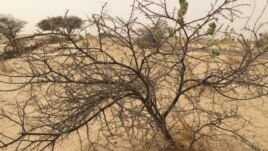07 May, 2017
The Sahel area in Africa has some of the most explosive storms anywhere in the world.
Scientists often blame the severe weather for causing flooding and the spread of disease.
A new report examines the effect of climate change on the area. It says slowly rising surface temperatures have caused the number of extreme storms there to triple in the past 35 years.

Dry plants in the Sahel, Niger, on April 16, 2017 (VOA/Nicolas Pinault)
The Sahel includes parts of 10 countries in western and north-central Africa. It extends from Senegal to Sudan.
The United Nations says the Sahel has people living in poverty and rising population growth. It also faces food crises, armed conflicts and violence. U.N. officials are warning that about 30 million people in the Sahel will not have enough to eat this year. Scientists say climate is making things even worse by affecting weather.
In one major Sahelian storm in 2009, more than 260 millimeters of rain fell in just a few hours. About 150,000 people in Ouagadougou, the capital of Burkina Faso, were forced to flee their homes.
Christopher Taylor is one of the writers of the new report. He is a weather expert at the Britain-based Center for Ecology and Hydrology.
Taylor led an international team of researchers who examined the link between Sahelian storms and rising temperatures in Earth's atmosphere. He says large storms moving across Africa use humidity in the atmosphere for fuel.
"The Sahara Desert has been warming up very rapidly in response to greenhouse gas emissions from around the world and that's changed the difference in temperature across Africa. And these differences in temperature affect the wind fields, the wind patterns and, in turn, that affects the efficiency with which these storms can produce rainfall. And so, the warming of the Sahara has made these storms much more intense."
Taylor says the number of extreme storms has increased 200 percent in recent years.
"In the early 1980s, we might have seen one of these every five days. But now we would see two in every three days. It's a really strong change that we're seeing."
Douglas Parker is a professor of meteorology at the University of Leeds. He helped write the study.
"These storms go very high in the atmosphere. And again that's what's really special about West Africa. They go up to 16 or 17 kilometers. The deeper they go, the more intense they are and usually the more rainfall they bring."
Parker adds that the storms are strong and cover a large area.
"...they very often have a line of very heavy rain. And they sweep across with a line that is, you know, maybe several hundred kilometers from north to south. If these are approaching, then they cover a wide swath and they affect a lot of people."
Parker says while the number of extreme storms has tripled, the number of average storms has not. But he says even these average storms are powerful.
The rain is needed because it provides water to grow crops. But Christopher Taylor says too much water can be just as harmful as too little.
"The rain that's falling is coming much more intensely. So, that can erode the soils. And also much of the rain runs off. So it doesn't percolate into the soil, so the crops can't make use of it. So, that kind of process is gradually making the rainfall less useful, if you like, for agricultural production."
Taylor says the study will be used to help people in Ouagadougou deal with climate change as the city quickly grows. New living areas are needed along with roads, water storage areas and other infrastructure.
Experts says farmers must plant crops that can deal with the strong storms. Parker says this is important, because climate change will continue and will make storms in the Sahel even more extreme.
I'm Jonathan Evans.
VOA's Joe DeCapua reported on this story from Washington. Christopher Jones-Cruise adapted his report for Learning English. George Grow was the editor.
We want to hear from you. Write to us in the Comments Section, or visit our 51VOA.COM.
________________________________________________________________
Words in This Story
triple – v. to make three times as great; to increase by 200 percent
humidity – n. an amount of wetness, especially in the air
rapidly – adj. quickly
greenhouse gas emissions – n. carbon dioxide and other gases that scientists have linked to rising temperatures in Earth's atmosphere
efficiency – n. the amount of level of effectiveness
meteorology – n. a science that deals with the atmosphere and weather conditions
swath – n. a long, wide area or space
erode – v. to eat away or break down
run off – v. to wash away
percolate – v. to become lively